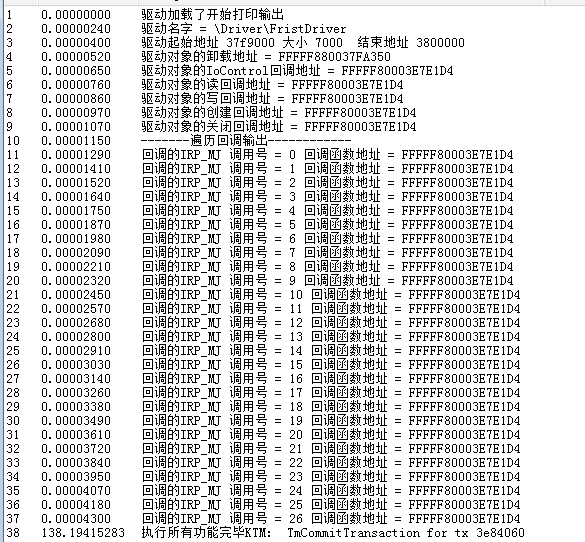溫馨提示×
您好,登錄后才能下訂單哦!
點擊 登錄注冊 即表示同意《億速云用戶服務條款》
您好,登錄后才能下訂單哦!
本篇內容介紹了“如何獲取ntoskrnl.exe基址”的有關知識,在實際案例的操作過程中,不少人都會遇到這樣的困境,接下來就讓小編帶領大家學習一下如何處理這些情況吧!希望大家仔細閱讀,能夠學有所成!
目錄
驅動對象講解
1.1 結構
1.2 輸出代碼輸出基本的驅動對象信息
1.3 結果
在內核中. 每一個驅動模塊都是一個驅動對象. 都有一個 DRIVER_OBJECT結構體代表. 可以想象成驅動對象是一個進程容器. 容納百川.
下面針對驅動對象做一下簡單的成員輸出.以熟悉驅動對象.
驅動對象結構如下:
typedef struct _DRIVER_OBJECT {CSHORT Type;CSHORT Size;//// The following links all of the devices created by a single driver// together on a list, and the Flags word provides an extensible flag// location for driver objects.//PDEVICE_OBJECT DeviceObject;ULONG Flags;//// The following section describes where the driver is loaded. The count// field is used to count the number of times the driver has had its// registered reinitialization routine invoked.//PVOID DriverStart; //驅動對象的起始地址ULONG DriverSize; //驅動對象的大小PVOID DriverSection; //驅動對象結構.可以解析為_LDR_DATA_TABLE_ENTRY 是一個鏈表存儲著下一個驅動對象 PDRIVER_EXTENSION DriverExtension; //驅動的擴展信息.可以自定義存放我們的數據 //// The driver name field is used by the error log thread// determine the name of the driver that an I/O request is/was bound.//UNICODE_STRING DriverName; //驅動對象的名字//// The following section is for registry support. This is a pointer// to the path to the hardware information in the registry//PUNICODE_STRING HardwareDatabase;//// The following section contains the optional pointer to an array of// alternate entry points to a driver for "fast I/O" support. Fast I/O// is performed by invoking the driver routine directly with separate// parameters, rather than using the standard IRP call mechanism. Note// that these functions may only be used for synchronous I/O, and when// the file is cached.//PFAST_IO_DISPATCH FastIoDispatch;PDRIVER_INITIALIZE DriverInit;PDRIVER_STARTIO DriverStartIo;PDRIVER_UNLOAD DriverUnload; //驅動對象的卸載地址PDRIVER_DISPATCH MajorFunction[IRP_MJ_MAXIMUM_FUNCTION + 1];
} DRIVER_OBJECT;typedef struct _DRIVER_OBJECT *PDRIVER_OBJECT;#include <ntddk.h>
VOID MyDriverUnLoad(
_In_ struct _DRIVER_OBJECT* DriverObject
)
{
DbgPrint("驅動卸載了\r\n");
}extern "C" NTSTATUS DriverEntry(
_In_ PDRIVER_OBJECT DriverObject,
_In_ PUNICODE_STRING RegistryPath
){
ULONG64 uImage = 0;
DriverObject->DriverUnload = MyDriverUnLoad;
DbgPrint("驅動加載了開始打印輸出\r\n");
DbgPrint("驅動名字 = %wZ \r\n", DriverObject->DriverName);
DbgPrint("驅動起始地址 %x 大小 %x 結束地址 %x\r\n",
DriverObject->DriverStart,
DriverObject->DriverSize,
uImage = ((ULONG64)DriverObject->DriverStart + DriverObject->DriverSize));
DbgPrint("驅動對象的卸載地址 = %p\r\n", DriverObject->DriverUnload); //輸出驅動對象的所有回調地址.
DbgPrint("驅動對象的IoControl回調地址 = %p\r\n", DriverObject->MajorFunction[IRP_MJ_DEVICE_CONTROL]);
DbgPrint("驅動對象的讀回調地址 = %p\r\n",DriverObject->MajorFunction[IRP_MJ_READ]);
DbgPrint("驅動對象的寫回調地址 = %p\r\n",DriverObject->MajorFunction[IRP_MJ_WRITE]);
DbgPrint("驅動對象的創建回調地址 = %p\r\n",DriverObject->MajorFunction[IRP_MJ_CREATE]);
DbgPrint("驅動對象的關閉回調地址 = %p\r\n",DriverObject->MajorFunction[IRP_MJ_CLOSE]);
DbgPrint("-------遍歷回調輸出------------\r\n"); //宏從DrverObject對象中查找for (auto i = 0; i < IRP_MJ_MAXIMUM_FUNCTION; i++)
{
DbgPrint("回調的IRP_MJ 調用號 = %d 回調函數地址 = %p \r\n", i, DriverObject->MajorFunction[i]);
}
DbgPrint("執行所有功能完畢"); return STATUS_SUCCESS;
}
“如何獲取ntoskrnl.exe基址”的內容就介紹到這里了,感謝大家的閱讀。如果想了解更多行業相關的知識可以關注億速云網站,小編將為大家輸出更多高質量的實用文章!
免責聲明:本站發布的內容(圖片、視頻和文字)以原創、轉載和分享為主,文章觀點不代表本網站立場,如果涉及侵權請聯系站長郵箱:is@yisu.com進行舉報,并提供相關證據,一經查實,將立刻刪除涉嫌侵權內容。